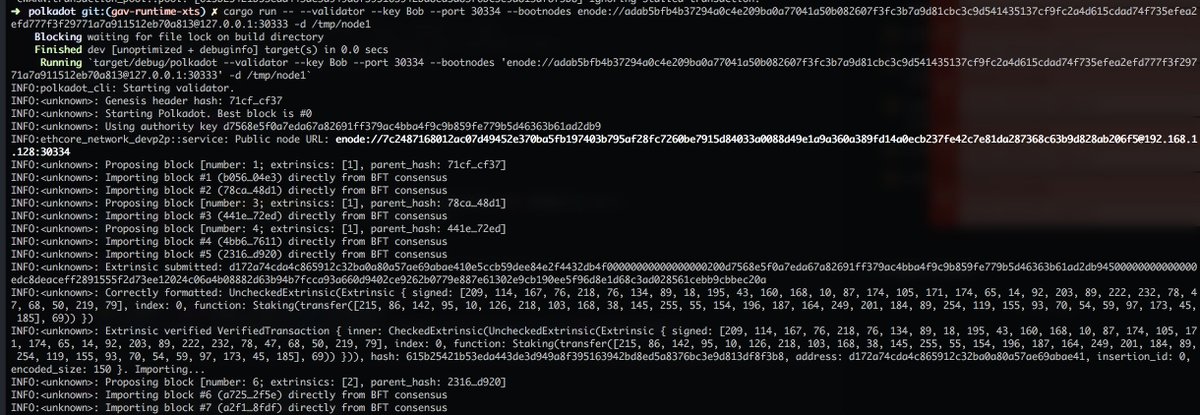The Acala team recently announced support for EVM-based smart contracts in their parachain. In short, this means that smart contracts that run on Ethereum can be run on their parachain. As they are targetting DeFi use case, I think that’s a great way to garner adoption. It’s also a bold strategy as I will outline below.
Continue reading “Bold move from Acala: EVM support coming!”Step-by-step instructions: staking with Ledger devices
Wondering how to stake your dots with a Ledger device? Fortunately u/cryptovestor gave a nice set of instructions in a reply on r/dot. Check them out:
Assuming you have installed the Polkadot app on your Ledger, you can do it all at polkadot.js by enabling Ledger support in settings tab. Then you connect your Ledger, unlock it and hit the “Query Ledger” button on the accounts page. Now your Polkadot account on your Ledger should show up in the list of accounts.
I plan to use the hw wallet to protect just the stash account, like so: (this is my plan, yours may differ)
- Unbond all stake in existing accounts and wait for unbonding period
- Move funds to Ledger’s Polkadot address
- Create a new controller account using the polkadot{.js} web extension
- Assign controller account to ledger polkadot account using “change controller account” function here
- Bond the funds at the new Ledger address
- Manage nominations via the new controller account.
This results in the stash being protected by the ledger but I can still manage nominations with the controller account, which doesn’t have the rights to transfer my funds.
Stakin4All blog
In addition to the above guide from cryptovestor, there is a great guide written by Stakin4All on Medium. It goes into some depth about using the Ledger device, including how to stake.
There is a great use of pictures too, so I recommend checking it out:
Staking / Nominating in Polkadot
Two excellent videos to share with you here. They show you how to stake / nominate your dots (or KSM) via the Polkadot.js UI.
One from Bill Laboon at W3F and one from Sam Eugene a community member. The first one from bill is essentially an official video althogh the UI has updated since he did the video back in June.
A simple overview of Polkadot
A friend sent me a video that I thought did a nice job of summarizing some of the key points of Polkadot. So let me share it with you too!
Relaunch of Polkadot Market
After taking a break for the past ~2 years while I worked at the foundation, I am now back into community building mode.
Polkadot Market was the first fan website created for the Polkadot community. The Reddit was launched 29th July 2019 and this website shortly followed afterwards!
I had to take a break while working full-time, but now that I’m out, I can spend more time fostering the community. The plan is to have more blog post and more Reddit discussions. Plus I’d love to do some interviews with the Polkadot community and get those posted to (e.g.) YouTube.
Useful Links
Recent developments in Polkadot: August 2018
This month’s highlights include 1 million blocks on the test net, an awesome demo from Patrick at Clovyr, and Gavin Wood’s interview on Bloomberg. August was a strong month for Polkadot news!
Continue reading “Recent developments in Polkadot: August 2018”
Recent developments in Polkadot: July 2018
There was a marked pick up in communications from the Polkadot team in June (see previous blog). In part due to the hiring of Jack Plats into the Web3 Foundation team, which increased capacity but also saw better internal alignment.
July saw the release of PoC2 and a major milestone in the evolution of blockchain technology: the first ever on-chain upgrade of a public network. Also the deployment of the first parachain!
Continue reading “Recent developments in Polkadot: July 2018”
Recent developments in Polkadot: June 2018
Since the last update we’ve had the first release of the Polkadot test net (PoC1) and we are now on to the second version of the test net. The transition to the second test network was handled smoothly via an on-chain upgrade which is the first time that’s happened on a public chain.
However, a lot has happened so let’s have a recap!
Continue reading “Recent developments in Polkadot: June 2018”
Recent developments in Polkadot (April / May 2018)
The high price of ether at $1000 back in January was certainly a heart-pounding time in the market; however, the biggest developments for Polkadot so far were released in April 2018.
Let’s have a recap.
April 10th – First External Transaction
Gavin posted a picture of the the first external transaction to be validated (and finalised) on a Polkadot chain. He was running a local testnet on his laptop.

Continue reading “Recent developments in Polkadot (April / May 2018)”
Vector bonds: dynamic consensual liquidity in DPoS blockchains
tl;dr: bonds which have dynamic liquidity and payout.
The idea for this post was inspired by a comment in the Polkadot whitepaper (PDF). As you will hopefully be aware of by now is that the upcoming Polkadot network will be Proof of Stake and consequently earning a block reward will require staking coins (“dots” in this case).

Image source: https://polkadot.network
In the whitepaper the value of the minimum holding period and the payout are static single values. My suggestion is to make both dynamic and to allow the values to be set by the market. The suggestion of a ‘vector bond’ is that you have a single address making multiple nominations to a validator at different levels of lock-in / return.
The word “vector” should probably be replaced by “array” but the former was the first that popped into my head, and sounds more pleasant on the ears, but the word “array” is more fitting from a technical accuracy point of view.
Continue reading “Vector bonds: dynamic consensual liquidity in DPoS blockchains”

